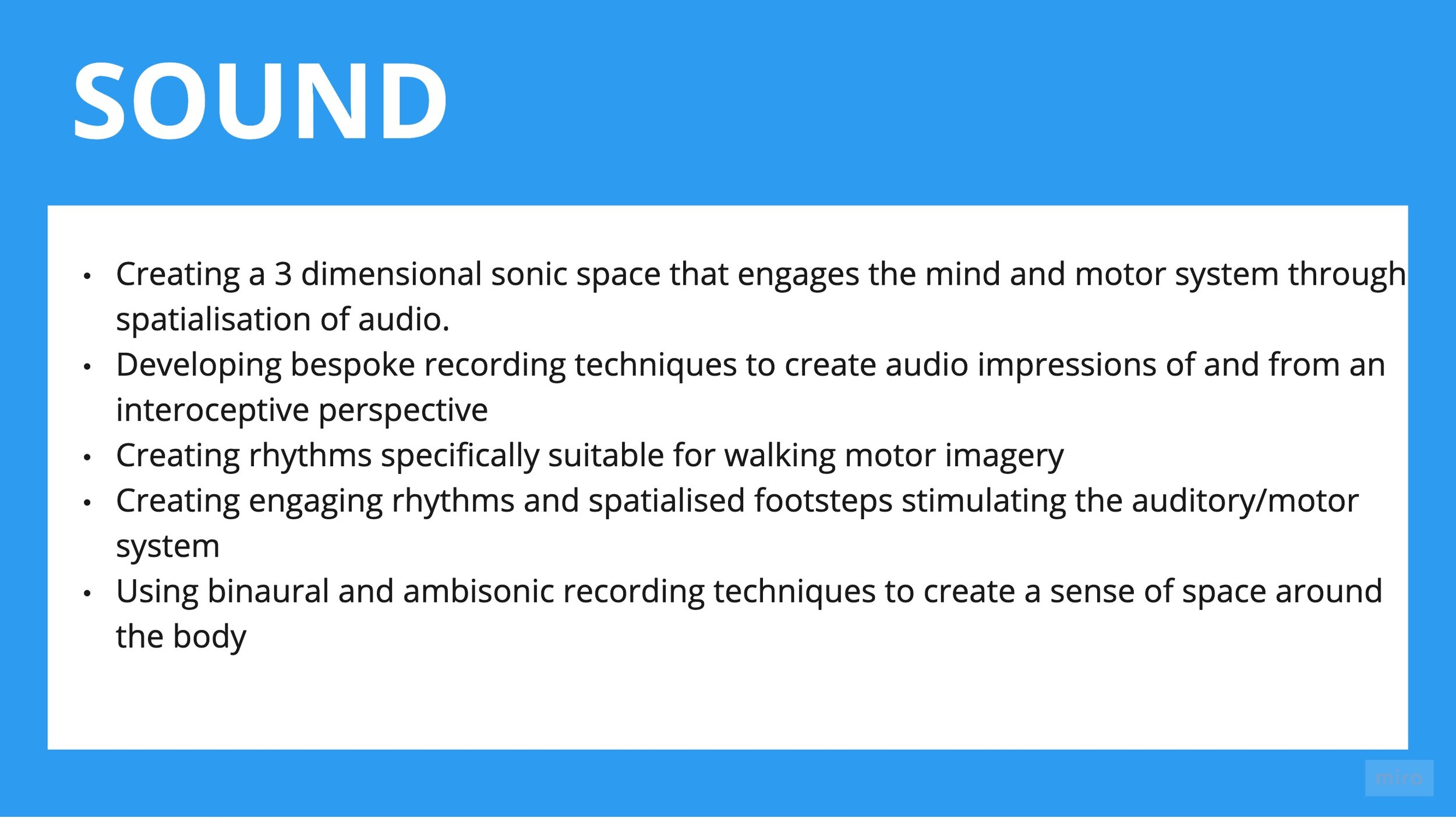Worldbuilders
Immersive Audio for Parkinson’s PhD Project
Thank you for taking an interest in my research project in which I am creating immersive audio stories for people living with Parkinson's disease.
The Researcher
My name is Hanna Slattne. I am a PhD research student at Queen’s University Belfast. My background is in storytelling for theatre, performance and immersive audio.
I have personal experience through family and friends of Parkinson’s disease.
The Research Project
My project is combining mental motor imagery exercises and instructions with story and an immersive soundscape. The stories incorporate audio cues for everyday movements such as walking, sensory information and body awareness.
The innovation of the project is the use of immersive audio to enhance motor imagery practice by engaging the auditory motor system and connecting actions with the virtual environment.
The project was developed in consultations with people living with Parkinson’s disease.
Some terminology:
Immersive Audio - a 360 soundscape recorded with special microphones to achieve a sense of depth and spatialised sounds in a similar way to how our ears hears the world.
Motor Imagery - The act of imagining movements or actions without physically moving.
References to published papers
Story - In this project I refer to story as an imaginary narrative, context or environment within which to practice motor imagery skills.
An interdisciplinary Arts & Health project - click to enlarge image
Benefits:
Learning and practicing motor imagery skills through creative exercises of the imagination.
Creating motor imagery with sensory details with precision and from the 1st person perspective.
Easy to use in your own home through a smartphone and a set of headphones.
Developing and keeping up the skill through engaging stories and immersive audio experiences
Stimulating and emotionally engaging exercises without feeling like treatment, encouraging continued practice as repetition is important.
“This study provides preliminary evidence for the clinical application and effectiveness of imagery training in PD. The demonstrated gains in imagery ability and motor and non- motor functions in people with PD following Dynamic Neuro-cognitive Imagery training further support the incorporation of imagery training in PD rehabilitation. Research into imagery and motor control and planning in PD is warranted.”
Project Aims and challenges
The project aims of incorporating motor imagery within the narrative and sound design presented challenges to traditional immersive storytelling techniques. It required innovative approaches, unique sound design solutions and a sensitivity to the needs of the specific audience of people living with Parkinson’s disease, the need for repetition of the exercises and creating a range of engaging audio outputs.



“Motor Imagery is a complex process that is not easy to integrate into clinical practice. Its association with physical practice (PP), however, seems to be more effective than PP alone in enhancing motor function.”
Audio Example
Below is an edited extract from The Cave. Please use headphones to best enjoy the spatialised immersive sound design.
This extract features audio cues consisting of interlaced footsteps, rhythms and music at 80 beats per minute. Structurally it alternates between story and walking sequences to allow for rest and refocus.
The PhD project portfolio consists of:
Practice Audios
Immersive Audio stories
‘Walk With Me’ app for walking
Portofolio:
Practice Audios:
1 - Sensory focus - an audio focussing on imagining a lemon focussing on all the senses: taste, smell, touch, sight and sound.
2 - Conscious movement - an audio exploring the connection between developing Motor Imagery skills and conscious movement.
3 - Rhythms and motor imagery - an audio to practice the connection between a heard rhythm and motor imagery.
4 - Environments - An audio providing three different immersive sound environments in which to practice motor imagery walking.
Immersive Audio Stories:
Through out the project I have developed 3 different approaches to merging story and motor imagery exploring different narrative and structural approaches.
The stories are between 15 and 35 minutes long: The Phonecall, Forest and Walk, The Cave.
Walk With Me App
Walk With Me is an app which is linked to the GPS (global positioning system) function on a smartphone. It triggers a new audio every 100 meters, with simple creative prompts and reflections to stimulate the imagination and motor imagery.
The thesis will cover the practical process, discoveries and the input from creative consultations with people living with Parkinson’s disease.
Addressing the practical work through the theoretical lens of enactive cognition, an embodied approach that argues that cognition evolves dynamically through action and interaction with the world around you. The thesis will explore how language, story and sound enhance the creation of motor imagery and, how that in turn effect the body.
The Future
Identify partners; health professionals, academic researchers and funders, to explore the long term effects of using the portfolio of practice and story audios.
Explore further, how to support experiencing Parkinson's symptoms whilst focussing on motor imagery of unhindered movements with more in-depth and in person consultations.
Work with Parkinson's health professionals to see how the project can be tailored to the needs of health practitioners as well patients.
Work with other writers and sound artists to produce a range of immersive audio materials.
If you are interested in the project and in developing it for the future, please get in touch.
Thank you for you interest!
Contact details:
Researcher: Hanna Slattne
Email: hslattne01@qub.ac.uk
Supervisor: Prof. Paul Stapleton
E-mail: p.stapleton@qub.ac.uk
Queen’s University Belfast, School of Arts, English and Languages Ethics committee has reviewed and approved this research project.






